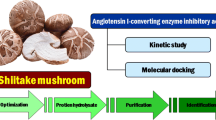Abstract
Angiotensin I-converting enzyme (ACE) inhibitory peptides have been shown to have antihypertensive effects and have been utilized for physiologically functional foods and pharmaceuticals. The ACE inhibitory ability of a hydrolysate is determined by its peptide composition. However, the peptide composition of a hydrolysate depends on proteolytic enzyme and the hydrolysis conditions. In this study, the effect of process conditions on the ACE inhibitory activity of rice dregs hydrolyzed with a trypsin was investigated systematically using response surface methodology. It was shown that the ACE inhibitory activity of rice dregs hydrolysates could be controlled by regulation of five process conditions. Hydrolysis conditions for optimal ACE inhibition were defined using the response surface model of fractional factorial design (FFD), steepest ascent design, and central composite design (CCD).
Similar content being viewed by others
References
Baek, H.H., Cadwallader, K.R., 1995. Enzymatic hydrolysis of crayfish processing by-products.Journal of Food Science,60(5):929–935.
Chen, Q.H., He, G.Q., Mokhtar, A.M., 2002. Optimization of medium composition for the production of elastase byBacillus sp. EL31410 with response surface methodology.Enzyme and Microbial Technology,30(5):667–672 (in Chinese).
Diniz, F.M., Martin, A.M., 1996. Use of response surface methodology to describe the combined effects of pH, temperature and E/S ratio on the hydrolysis of dogfish (Squalus acanthias) muscle.International Journal of Food and Technology,31(5):419–426.
Haaland, P.D., 1989. Statistical Problem Solving.In: Experimental Design in Biotechnology. Marcel Dekker, Inc., New York and Basel, p. 1–18.
Ibanoglu, S., Ibanoglu, E., Ainsworth, P., 1998. Effect of dilute acid hydrolysis on the cooked viscosity of tarhana, a traditional Turkish cereal soup.International, Journal of Food Science and Nutrition,49(6):463–466.
Khuri, A.I., Cormell, J.A., 1987. Response Surfaces: Designs and Analysis. Marcel Dekker, New York.
Koike, H., Ito, K., Miyamoto, M., Nishino, H., 1980. Effects of long-term blockade of angiotensin-converting enzyme with captopril (SQ 14, 225) on hemodynamics and circulating blood volume in SHR.Hypertension,2(3): 229–303.
Liu, F.F., Ang, C.Y.W., Springer, D., 2000. Opitimization of extraction conditions for active components in Hypericum perforatum using response surface methodology.Journal of Agricultural and Food Chemistry,48(8): 3364–3371.
Maruyama, S., Miyoshi, S., Kaneko, T., Tanaka, H., 1989. Angiotensin I-converting enzyme inhibitory activites of syntheticpeptides related to the tandem repeated sequence of a maize endosperm protein.Agricultural and Biological Chemistry,51(2):1581–1586.
Montagomery, D.C., 1991. Design and Analysis of Experiments. 3rd Ed., Wiley, NY.
Ondetti, M.A., Rubin, B., Cushman, D.W., 1977. Design of specific inhibitors of angiotensin I-converting enzyme: New class of orally active antihypertensive agents.Science,196(1):441–444.
Oshima, G, Shimabukuro, H., Nagasawa, K., 1979. Peptide inhibitors of angiotensin I-converting enzyme in digests of gelatin by bacterial collagenase.Biochimica et Biophysica Acta,566(1):128–137.
Seki, E., Osajima, K., Matsufuji, H., Matsui, T., Osajima, Y., 1995. Val-Tyr, an angiotensin I-converting enzyme inhibitor from sardines that have resistence to gastrointestinal proteases.Nippon Nogeikagaku Kaishi,69(4): 1013–1020.
Vermeissen, V., Van Bent, A., Van Camp, J., Van Amerongen, A., Verstraete, W., 2004. A quantitative in silico analysis calculates the angiotensin I-converting enzyme (ACE) inhibitory activity in pea and whey protein digests.Biochimie,86(3):231–239.
Yoshii, H., Tachi, N., Sakamura, O., Takeyama, H., Ohba, R., Itani, T., 1999. Antihypertensive effect of oligo-peptide derived from hens eggs.Nippon Shokuhin Kagaku Kogaku Kaishi,46(12):45–50.
Author information
Authors and Affiliations
Corresponding author
Rights and permissions
About this article
Cite this article
He, Gq., Xuan, Gd., Ruan, H. et al. Optimization of angiotensin I-converting enzyme (ACE) inhibition by rice dregs hydrolysates using response surface methodology. J Zheijang Univ Sci B 6, 508–513 (2005). https://doi.org/10.1631/jzus.2005.B0508
Received:
Accepted:
Published:
Issue Date:
DOI: https://doi.org/10.1631/jzus.2005.B0508




